Five years ago, I wrote a short blog entitled, The Last Train Out of Paris. I never heard from anyone about that blog until 19 June 2020 when Pat V. e-mailed me about her father, Squadron Leader (ret.) Stanley Booker, MBE. While my blog never mentioned any Allied airmen, it seems Stanley enjoyed reading it ⏤ he was one of 168 captured airmen on that last train out of Paris on 15 August 1944.
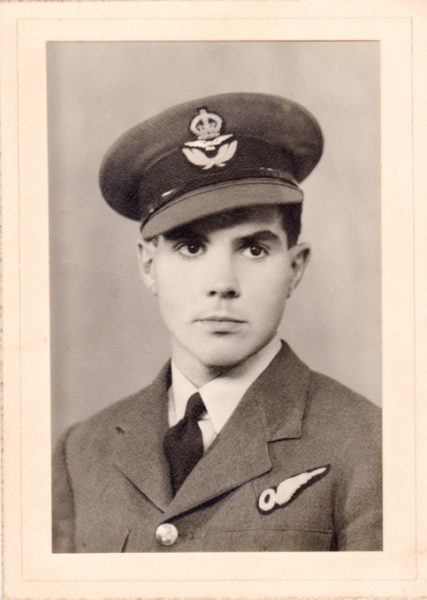
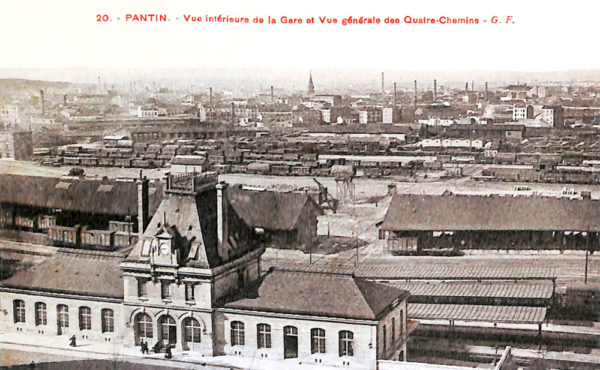
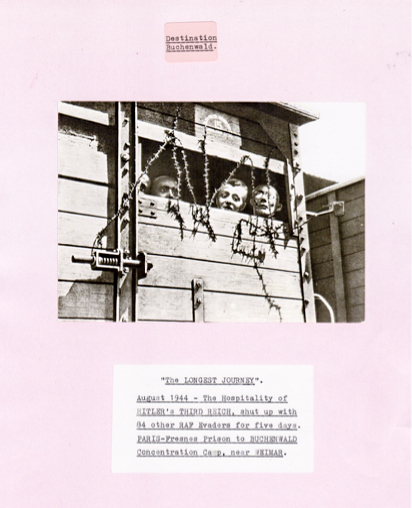
This has led to a lot of discussions over the past several months with Pat about her father’s war experiences. They live in the UK and Stanley is ninety-eight years young. The reason the story about these men didn’t make it into the original blog was, frankly, I didn’t know about it ⏤ well, now I do. One of Pat’s questions in her original e-mail was whether I knew about Jacques Désoubrie and who his German superior might have been. Her last words in the e-mail were “Can you help please?” I couldn’t resist and quickly entered yet another rabbit hole. Once I came up for air, I had Désoubrie’s story, an idea who he reported to, and I knew I had to repost the 2015 blog albeit in an expanded manner with an abbreviated story about Stanley’s experiences. Stanley wrote a privately published version of his wartime escapades and Pat is completing the book as well as expanding on his post-war exploits ⏤ Stanley’s interesting life didn’t just end with his eventual retirement from the Royal Air Force.
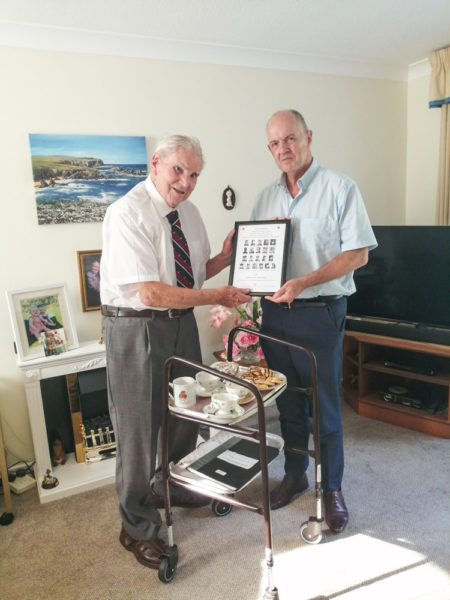
Did You Know?
Did you know that Curious George (click here to read the blog) wasn’t the only famous literary cartoon figure to come out of France during the German Occupation? Le Petit Prince, or The Small Prince was written by Antoine de Saint-Exupéry (1900-1944) while he was in the United States representing the Free French and trying to persuade our government to join the war against the Nazis. While Curious George and Mickey Mouse are familiar to many Americans, Le Petit Prince is much loved in the same way by the French. After his two years in America, Saint-Exupéry joined the Free French Air Force in North Africa. Before the war, he was a well-known and successful pilot. On 31 July 1944 while flying a reconnaissance mission out of Corsica, his plane went down in the Mediterranean. In 2000, his Lockheed P-38 airplane was found off the coast of Marseille. Fragments of the plane were transferred to the Paris museum, Musée de l’Air et de l’Espace. Saint-Exupéry was awarded numerous honors including two Légions d’Honneur. Ironically, the only museum devoted to Le Petit Prince is not in France but in Japan.

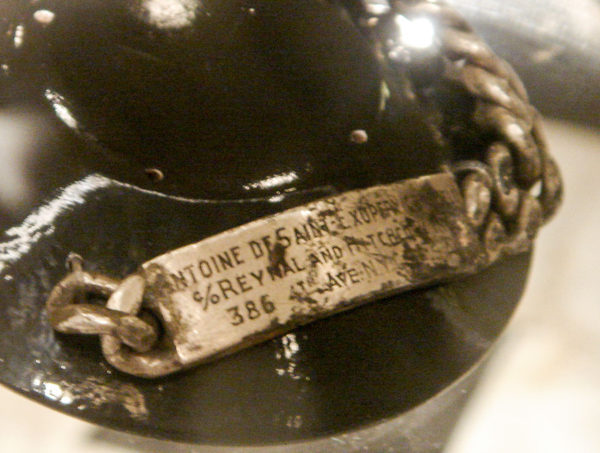
The Boulloche Family
At 3:00 a.m. on Sunday, 6 August 1944, Gestapo agents burst into the third-floor apartment belonging to Jacques (1888-1945) and Hélène (1888-1944) Boulloche at 28, avenue d’Eylau in Paris. The agents were there to arrest Jacques and Hélène’s twenty-year-old daughter, Christiane. The Boulloche sisters, Christiane (b.1923) and Jacqueline (1918-1994), and their brother, André (1915-1978), had joined the fledgling resistance movement in Paris at the outset of the Nazi occupation in June 1940. In January 1944, André was arrested by two Gestapo agents wearing their trademark black leather raincoats and now, the Gestapo were after his sisters.
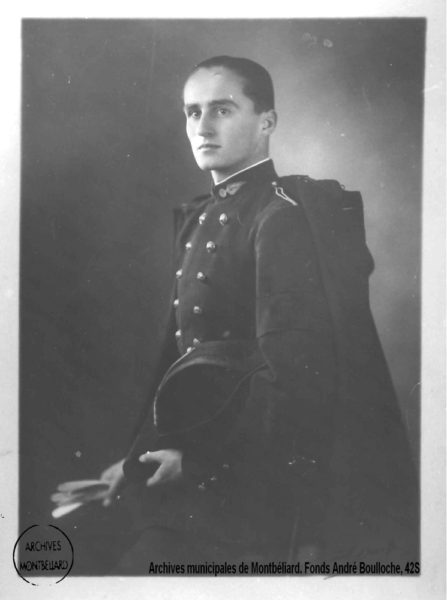
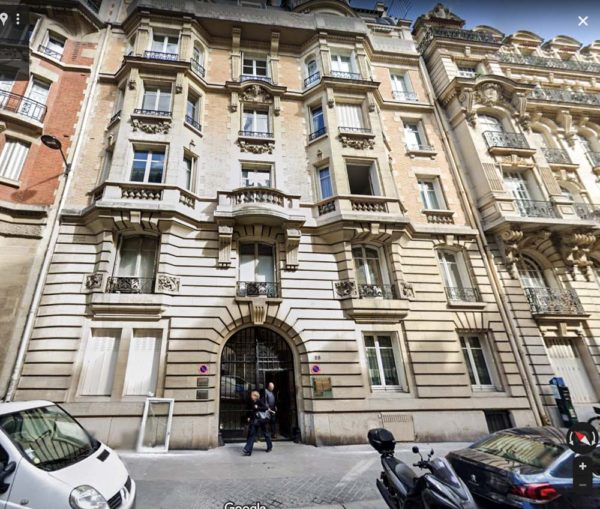
What made three of the Boulloche children different than most résistants? First of all, they survived ⏤ André was one of the few who returned from the extermination camps, including Auschwitz while his sisters managed to elude the Gestapo and ultimately, participated in the August 1944 liberation ceremonies. Second, they joined the resistance movement having no political agenda. They joined because it was the right thing to do.
Jacques, Hélène, and their oldest son, Robert (1913-1945) did not join the resistance. Jacques and Robert were mid-level government bureaucrats who felt it was their duty to keep the country running (albeit under the Vichy regime). While they knew the younger children were involved, the parents knew nothing of their resistance activities. As time went on, the Nazis stepped up their brutality towards the citizens of Paris and France. The new German policy was to arrest, torture, and deport immediate family members of known or suspected résistants.
The Gestapo and members of the Milice (a Vichy collaborationist para-military police) arrested Jacques, Hélène, and Robert on 6 August 1944. They were interrogated, tortured (Hélène was water boarded), and after determining none of them knew where Christiane could be found, the Nazis decided to put them on the last train out of Paris. Hélène died at Ravensbrück on 25 October 1944; Robert died at Dora-Buchenwald on 20 January 1945; Jacques died at Buchenwald on 19 February 1945.
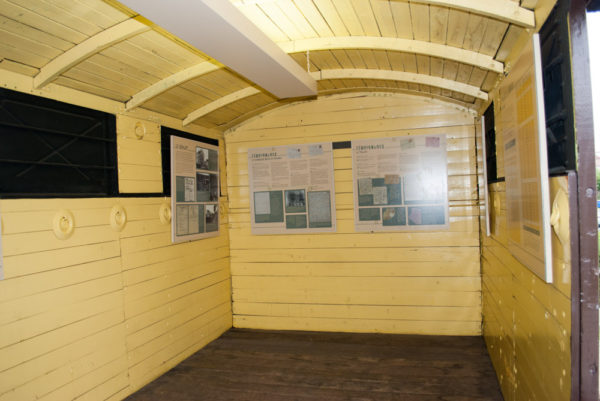
Dernier Convoi I.264: Last Train Out Of Paris
On 10 August 1944, the national rail workers went on strike with the slogan, “To make the Hun retreat, strike!” Two days later the Gare l’Est, one of the embarkation rail stations to the extermination camps, was crippled by the French Resistance. On 15 August, approximately 2,200 prisoners from Fresnes, la Santé, Cherche-Midi, and Romainville prisons, under the orders of General von Choltitz, were rounded up and taken to Gare de Pantin (rail station north-east of Paris where cattle herds were brought for transport) and loaded into thirty wagons. Choltitz considered them animals and purposely had the deportees enter the cattle cars from the quai au bestiaux, or animal platforms. The wagons were vintage World War I and normally held eight horses or forty men. That day, the wagons each had up to one hundred twenty human beings stuffed inside.
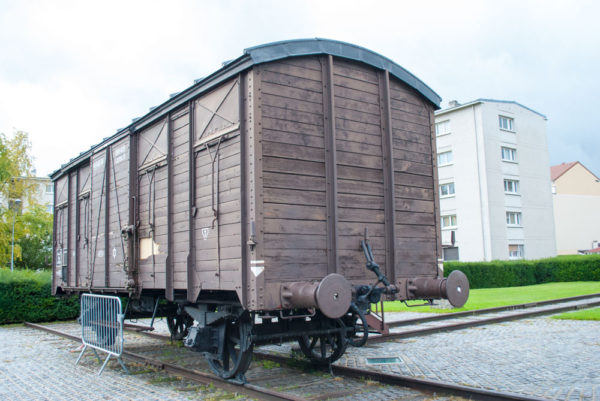
There were approximately twenty-two hundred men and women. The Nazis were not deporting Jews on this train (the last convoy from Drancy left on 18 August with Jews bound for Auschwitz). The Germans knew their days in Paris were numbered and they emptied the prisons of political prisoners, résistants, and captured airmen who were officially considered terrorists (“Terror Fliegers”). The destination for the 1,650 men was KZ Buchenwald while the 550 women ended up in KZ Ravensbrück. The deportees included the three members of the Boulloche family, George and Geneviève Prévôt (they sheltered airmen including Phil Lamason), Toquette Jackson (wife of Dr. Sumner Jackson, head of the American Hospital in Paris), Virginia d’Albert-Lake (member of the Comet escape line), Philip Aribaud (founder of the Jade-Amicol circuit), Georges Clément (SOE agent who was able to get a message to Andrée Goubillon of the réseau Sussex), and one hundred sixty-eight downed Allied airmen.
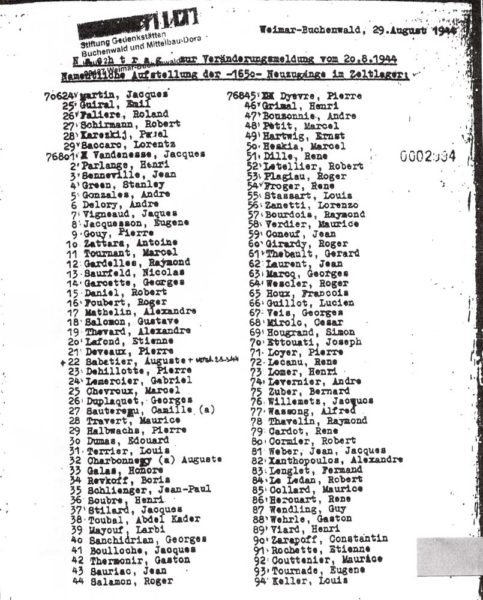
It was insanely hot that day and the temperatures inside the wagons caused many to faint or worse. The Red Cross managed to get authorization to hand out packages as well as the release of sick and pregnant prisoners. The train pulled out of the Pantin station just before midnight and thirty minutes later, stopped in the Domont forest. The Schutzstaffel (SS) figured out they had some high-ranking resistance leaders on board. André Rondenay, who led the coordination of Maquis sabotage activity leading up to D-Day, and Alain de Beaufort, a leader of the London based Free French intelligence network along with three others were taken off the train, marched into the forest, and executed by the SS (the three SS officers returned to Paris and Gestapo headquarters where they had what they referred to as “an executioner’s banquet”).
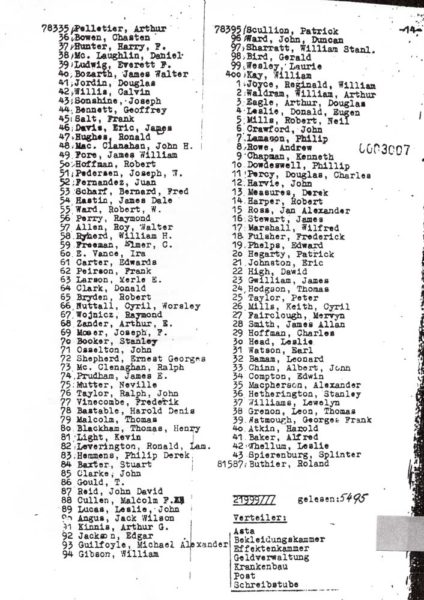
The train continued on its way and on 16 August at Nateuil-Saâcy, its human cargo was transferred to a new train. Over the next several days, attempts by various outsiders to get the SS to stop the convoy were unsuccessful. On 19 August, the train reached Weimar, Germany and the next day, it arrived at its first stop: Buchenwald. The men were unloaded, and the train with the women proceeded on to Ravensbrück.
Gestapo Traps
The 168 downed Allied airmen on the last convoy were primarily British, American, and Canadian. They flew their missions in B-17, B-24, Halifax, and Lancaster heavy bombers as well as P-51, P-38, and P-47 fighters. Many of them were captured in June and July 1944. Approximately forty-one percent of them were captured in traps set up by the Gestapo double agent, Jacques Désoubrie (alias Jean Masson, Pierre Boulain, and Jean-Jacques). His Nazi handlers gave him orders to “collect the evaders.” Désoubrie maintained two separate Paris apartments at 29, rue de Douai. One was for his family while the other was used as a Gestapo rendezvous room where the airmen were brought and turned over to the Gestapo. An additional site where the captured men were held was the Hôtel Piccadilly. This was a popular rendezvous for German soldiers and their lady friends.
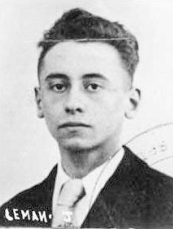
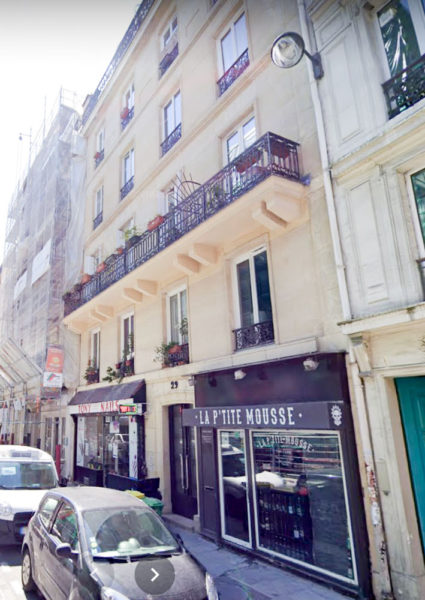
Désoubrie was responsible for infiltrating the Comet escape line and sending its leader, Andreé de Jongh, to Ravensbrück. He also picked up evading airmen through his activities with the Picourt network, an escape line set up by Raymond Picourt. Désoubrie became a trusted agent and he brought the airmen to his family apartment before the expected trip over the Pyrennes into Spain and onto London. Unfortunately for the airmen, after a brief stay, Désoubrie took them to the other apartment where the Gestapo was waiting. The new prisoners were taken to Gestapo headquarters at Rue des Saussaies where interrogation and torture were carried out. Stanley Booker was one of approximately fifty-four British airmen during June and July 1944 who were betrayed by Désoubrie.
Jacques Désoubrie (1922-1949) was arrested in Germany on 10 March 1947 and handed over to the French for trial. Evidence presented at the trial indicated he was responsible for betraying 1,683 downed Allied airmen resulting in more than one thousand arrests. His last words before being shot were, “Heil Hitler!”
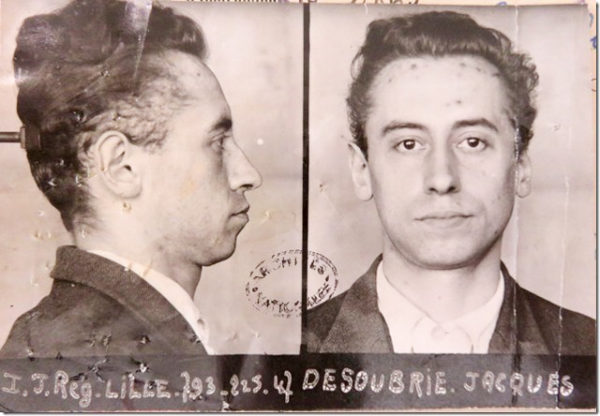
Buchenwald
The airmen arrived at Buchenwald where they were treated as terrorists and refused prisoner-of-war status. Their lives were unbearable. The men were made to sleep outside and some developed pneumonia and pleurisy. Things got even worse after Allied bombers destroyed a nearby factory killing three hundred prisoners and eighty SS men. Twice daily, the men had to fall in for roll call. The SS guards taunted the prisoners by telling them that the only way they would leave the camp was, “Up the chimney” ⏤ pointing to the crematorium chimney.
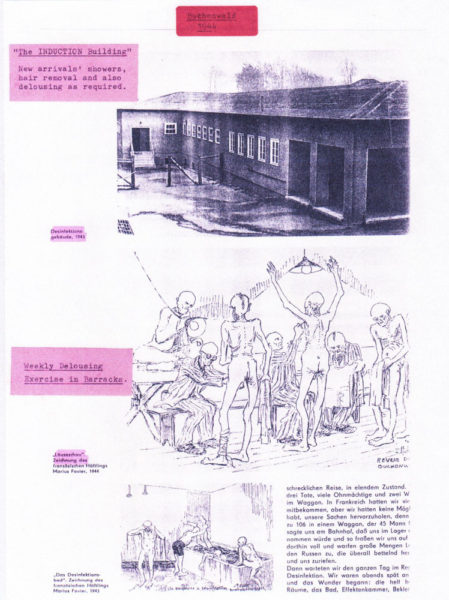
Phillip Lamason (1918-2012), a New Zealand pilot and senior officer of the group, tried to negotiate with the camp commander to obtain POW status for the men. His requests were denied, and unbeknownst to the men, their files read, Darf in Kein Anderes Lager, or roughly interpreted, the men were not to be transferred to any other camp. In other words, they were not going to leave Buchenwald alive.
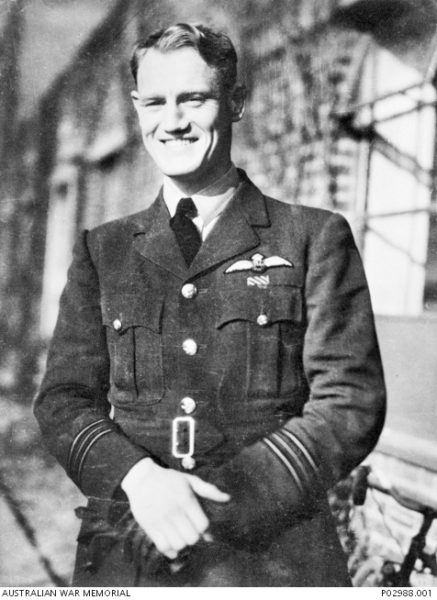
The Luftwaffe airfield next to Buchenwald was NOHRA, an experimental airfield where working parties were sent from the concentration camp. One of the trusted prisoners was able to smuggle out Lamason’s secret message notifying the Luftwaffe of the 168 airmen being held at Buchenwald as terrorists and not given POW status.
Oberst Hannes Trautloft (1912-1995) was a Luftwaffe officer in charge of all fighter activity when he was instructed to personally visit Buchenwald to determine whether the story was true. As he was about to leave the camp, an American airman who spoke fluent German shouted out to him. Trautloft ordered the SS guards to back off and heard the first-hand story of how the airmen ended up at Buchenwald. That same day, orders to execute the 168 airmen were received by the Buchenwald camp commander. Returning to Berlin, Trautloft relayed the story to Reichsmarschall Hermann Göring, head of the Luftwaffe. Concerned about the safety of Luftwaffe POWs held by the Allies if it became known Allied airmen were executed, Göring had the men transferred immediately out of Buchenwald to Stalagluft III.
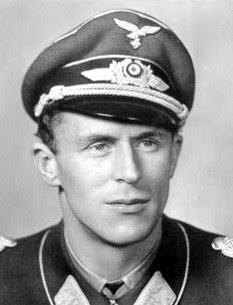
It seems ironic that the children of these airmen have Hermann Göring, a mass murderer and war criminal, to thank for their existence.
Stanley’s Story
Pat was kind enough to share a part of her father’s story with me. Stanley was the navigator on a Halifax heavy bomber that went down over France on 3 June 1944. He was handled by réseau Hunter and likely turned over to the Picourt network for eventual evasion over one of its escape lines. Stanley was betrayed by the German double agent, Jacques Desoubrie (aka Jean-Jacques), and arrested on 1 July 1944. Several months earlier, Désourbrie was introduced to Picourt and began “working” for the resistance network. One of Picourt’s trusted agents was Colette Orsini. She began an affair with Désoubrie shortly after he joined the Picourt network. The evading aviators turned over to Mrs. Orsini and Jean-Jacques included Stanley.
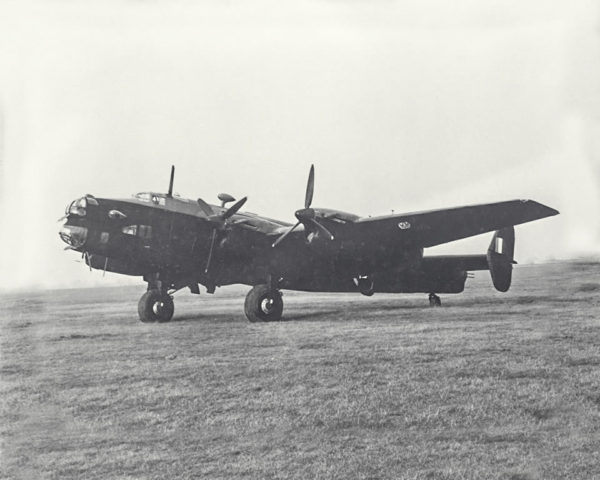
After being arrested by the Gestapo, Stanley was taken to Gestapo headquarters at 11, rue des Saussaies where the Nazis had their interrogation and torture rooms on the fifth floor. He endured a painful strip search, then beaten with rubber hoses, and finally, hauled off to Fresnes Prison. Stanley was put into solitary confinement in cell 429 on the upper floor. He changed cells every Friday and eventually, shared a cell with up to three other prisoners. Brutal interrogations continued on the fifth floor at Gestapo headquarters. The floors of the transport vans used to ferry the prisoners between the prisons and Gestapo cells were stained with blood and covered with vomit. Stanley recalls entering the courtyard and seeing prisoners waiting for transport back to the prisons ⏤ they were ragged, had clearly been physically abused, and were bleeding. As Stanley walked past the doors of the cells on the fifth floor (essentially small closets), he saw and heard prisoners being tortured; one was naked and tied down with interrogators approaching with flame torches. Many times, Stanley was beaten unconscious, but he never divulged the information the Nazis were after.
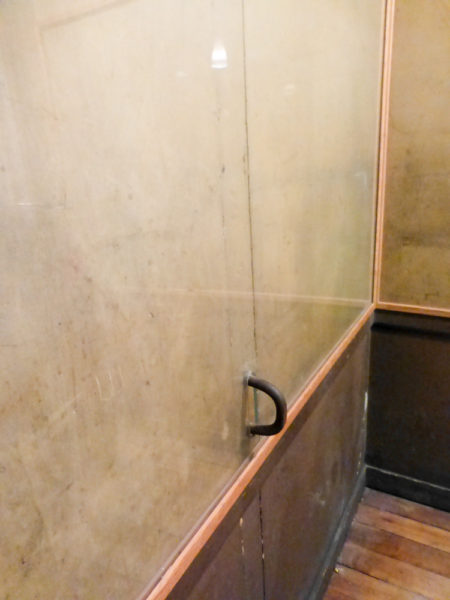
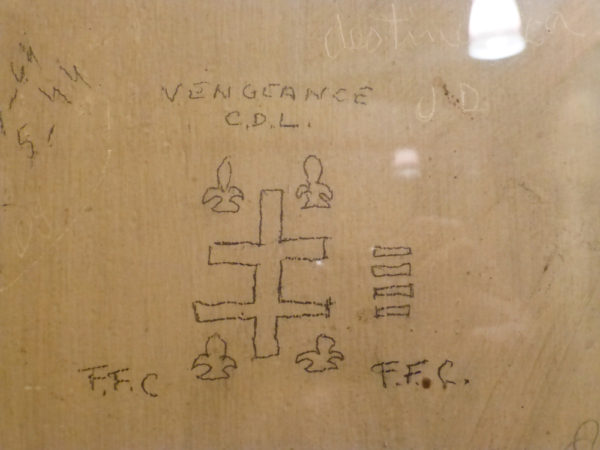
It wasn’t until 15 August when the prison was being emptied that Stanley realized how many other downed airmen there were besides himself. He says the men weren’t recognizable until they reached Buchenwald where they were forcibly given a full body shave.
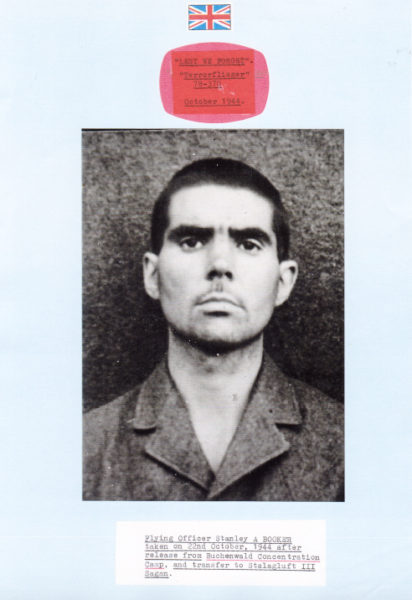
One hundred sixty-six men survived. After the war, they referred to themselves as the KLB Club (Konzentrationslager Buchenwald). Stanley Booker, MBE is the last surviving member.
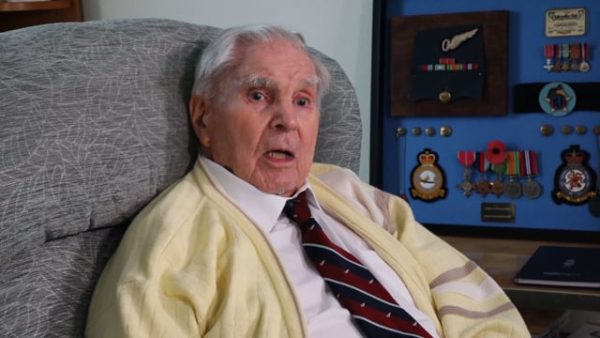
The official British military records of Lamason and Booker do not reflect the sixty-one days they were held at Buchenwald concentration camp or the months at Stalagluft III. Stanley would still like to know why there is a six-month gap in his official military service record but the British government refuses to divulge its reasons for denying this fact. What are they hiding?
✭ ✭ ★ Learn More About The Last Train Out Of Paris and 168 Allied Airmen ✭ ★ ★
Burgess, Colin. Destination: Buchenwald. Australia: Kangaroo Press, 1996.
Childers, Thomas. In the Shadows of War: An American Pilot’s Odyssey Through Occupied France and the Camps of Nazi Germany. New York City: Henry Holt and Company, 2002
Cobb, Matthew. Eleven Days in August. London: Simon & Schuster, 2013. Collins,
Larry and Dominique Lapierre. Is Paris Burning? New York: Warner Books Edition, 1965.
Kaiser, Charles. The Cost of Courage. New York: Other Press, 2015.
Kinnis, Arthur G. and Stanley A. Booker. 168 Jump Into Hell: A True Story of Betrayed Allied Airmen. Canada: Self-published, 1999. Maillet, Jean-Luc. Aviateurs déportés à Buchenwald: Aviators in Buchenwald. Click here to read.
Moser, Joseph. A Fighter Pilot in Buchenwald: The Joe Moser Story. Chicago: All Clear Publishing, 2009.
Colin Burgess wrote his book before many classified documents had been released. He is in the process of revising and updating the book for a second edition. Upon release, we will link the above reference to a site where you can purchase it.
Disclaimer:
There may be a chance that after we publish this particular blog, the video or internet links associated with the blog are no longer accessible. We have no control over this. Many times, whoever posts the video has done so without the consent of the video’s owner. In some cases, it is likely that the content is deemed unsuitable by YouTube. We apologize if you have tried to access the link and you don’t get the expected results.
What’s New With Sandy and Stew?
By the time you read this blog, the manuscript of my new book, Where Did They Put the Gestapo Headquarters? A Walking Tour of Nazi Occupied Paris (1940-1944) will be in the hands of our editor. Concurrent with our editor’s review of the manuscript, Sandy and I will begin the image selection process. Those of you who are familiar with my books know that images play a very important role. It’s a fun process but it can be frustrating ⏤ not being able to find the ones you want or when you do, they are of such low resolution that it is not possible to use them. However, I believe we can meet our self-imposed publication deadline of 1 December 2020. We’re looking forward to being able to provide you with another high quality and fun-to-read book. 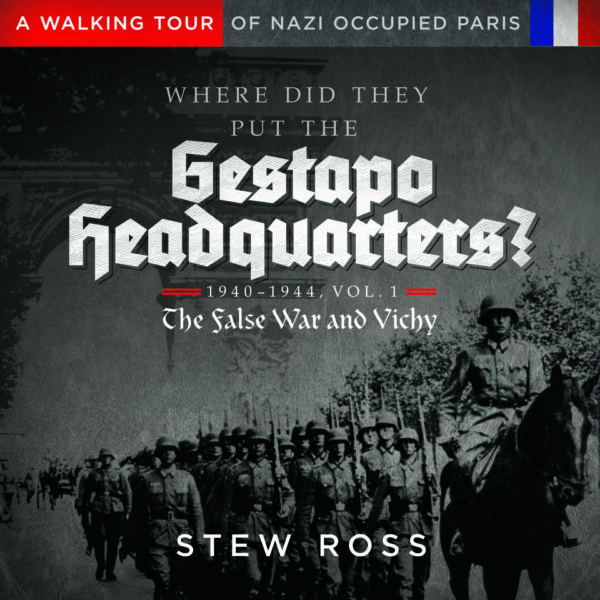 By the way, I apologize to all of you who have sent me messages and I have not replied in a timely manner (usually same or next day). My focus has been getting the book ready for the editor. Now I’m back to my “normal” routine, or at least until I begin the second volume of the Gestapo book (which if the world doesn’t return to “normal” soon, that book will be finished in much less time than it took for the first volume).
By the way, I apologize to all of you who have sent me messages and I have not replied in a timely manner (usually same or next day). My focus has been getting the book ready for the editor. Now I’m back to my “normal” routine, or at least until I begin the second volume of the Gestapo book (which if the world doesn’t return to “normal” soon, that book will be finished in much less time than it took for the first volume).
Thank you to all of you who subscribe to our bi-weekly blogs. It seems there isn’t a day that goes by where we don’t increase our readership. Please let your history buff friends and family members know about our blogs.
Someone Is commenting on Our Blogs
I’d like to thank Richard, President of the Association l’Alliance, for his assistance with information on Jacques Désoubrie. The Association l’Alliance is an organization founded by the children and grandchildren of the résistants of réseau Alliance (also known as Noah’s Ark-click here to read the blog). It is dedicated to preserving the memory of these brave men and women and their fight to rid France of the Nazis. Richard’s grandfather, Edward Kauffman (nom de guerre: Cricket), was third in command behind Marie-Madeleine Fourcade (Hedgehog) and Léon Faye (Eagle). Kauffman was executed by the Nazis. Click here to visit the reseaualliance.org web-site.
Squadron Leader (ret.) Stanley Booker, MBE and his daughter, Pat were a tremendous help in making sure I have my facts straight. Stanley should know ⏤ he was one of the Allied airmen on the last train out of Paris. I appreciate them sharing images for this blog. And since I’m on the topic, a big thank you to Stanley for agreeing to provide a testimonial for the upcoming book.
I would also like to thank Claire G. for reaching out to us regarding the blog, Racer, Spy and the Erotic Model (click here to read the blog). Claire is the granddaughter of Frederick Glover and the daughter of Frédéric Glover, brother of William Grover-Williams. Claire corrected a fact about her grandfather that showed up in the blog ⏤ I appreciated her pointing it out and it has been changed. In the blog, I referenced Joe Saward’s book, The Grand Prix Saboteurs. Mr. Saward mentions her father’s recollections many times. I am looking forward to my future discussions with Claire especially when Sandy and I can ever get back to Paris again.
If there is a topic you’d like to see a blog written about, please don’t hesitate to contact me. I love hearing from you so keep those comments coming.
Why Would You Want To Buy Our “Walks Through History” Books?
Simple.
You like to travel and experience history and historical events. You like to see original buildings that had a significant impact on the people and events of the history you’re engaged with. You want to know the stories behind the brick and mortar in front of you.
The walking tour books are meticulously researched so you can go directly to those sites and learn about the building’s history as well as an introduction to some of the more interesting people associated with it.
We Need Your Help
Please tell your friends about our blog site and encourage them to visit and subscribe. Sandy and I are trying to increase our audience and we need your help through your friends and social media followers.
Thank You
Sandy and I appreciate you visiting with us. We have some exciting things on the horizon and we’ll keep you updated as we go along.
Share This:
Follow Stew:
Find Stew’s books on Amazon and iBooks.
Please note that we do not and will not take compensation from individuals or companies mentioned or promoted in the blogs.
 Walks Through History
Walks Through History
Copyright ©2020 Stew Ross


Hi Stew,
Thank you for this brilliant blog ” last train out of Paris” – it is an excellent story, well told and illustrations excellent. My Father will be very proud of your work. Will share this with lots of family and friends.
Pat Vinycomb
Hi Pat;
I really enjoyed working with you and Stanley to put the blog together. I received a nice comment from a good friend of Phil Lamason and I have ordered his book. I appreciate you sending me the images that made the blog what it is. We’ll talk soon. STEW
Hi Pat. I just read about your father’s book when I commented on a post about Phil Lamson’s book. I’d love to read it but as I live in NZ (where Phil was from) the cost is unfortunately prohibitive as it’s a rare book and not available here. Best wishes
Hi Carolyn; Thanks for reaching out to us. I will pass your comments on to Pat. I believe Stanley’s book was privately published and is not available for sale. However, Pat is writing a book based on her father’s memoirs and filling in using available information. I think Pen & Sword is looking to publish her book in mid-2021. Again, thanks for following our bi-weekly blog. Hope to hear from you again. STEW
I was a close friend of Phil Lamason who was a Suadron Leader on this train and became the leader of the 168 in Buchenwald. He finally told his story to me which we have now made into a stunning book. Your pictures aand blog are so familiar to what he related to me. Well done, Glenys Scott New Zealand
Hi Glenys;
I appreciate you contacting me. Thank you so much for your kind words. I had a lot of fun putting the blog together and working with Pat and her father. I have ordered the book and looking forward to reading it. I hope you continue to enjoy the bi-weekly blogs. Take care. STEW
I am privileged to be a friend of Stan Booker.
Thank you for this great blog.
( I found it amazing that Desoubrie exclaimed ‘ Heil Hitler ‘ before he was executed ).
Hi David;
Thank you for contacting us. I appreciate your kind comment about the blog. It was a pleasure working with Pat and Stan on this blog. I hope you enjoy our future blogs. STEW
These events show many facets of human behaviour ,from the courage of the airmen and the Resistance , the decency of the Luftwaffe saving the lives of the prisoners by transferring them from a concertration to a POW camp and the evil of the Nazis.
An excellent blog, but I was somewhat disappointed that my book, “Destination: Buchenwald” was not listed in your bibliography (a couple of other books relevant to this story are also absent). I put together the stories of the Australian and New Zealand airmen from Buchenwald – including of course Phil Lamason – and even travelled to Canada to meet Art Kinnis who maintained contact with all the ex-KLB airmen. Over my research years I heard from and even met many of the airmen who were sent to Buchenwald, and even met Stanley Booker and Barbara Yeo-Thomas in London. It was one of the most moving and emotional books I have ever researched and written in my life, and a lot of what was told to me in private never made it into my book, as I promised it wouldn’t. None of the Aussies or Kiwis are still with us, but I know that their families – and families of other KLB airmen – have appreciated that I have told their stories, as many refused to ever talk about what they witnessed or experienced.
Hi Colin,
Thanks for your kind comment about the blog. Considering you are an expert on the 168 airmen, your comment means a lot. I apologize for not including the book but frankly, I was unaware it existed at the time I wrote the blog. I have added it to the blog and as soon as your updated and revised second edition is available, I will have Sandy link it to the Amazon page. When you wrote DB, many of the men were still alive. How exciting to be able to hear the first-hand accounts of their stories. Now, the official documents have been declassified which should add even more insight to the new edition. Best of luck and I’ll be on the lookout for the new edition. STEW
Thank you for this excellent blog. My father Edward Keith Phelps (known as Peter) was also one of the 168 allied airmen who was captured after being shot down on the evening of 7/8 July 1944 and was transported to Buchanwald on the same train. Before he died Dad did revisit Buchanwald and wrote his own recollections. I think he needed try to exorcise the memories. It’s didn’t help. I have also recently been to Buchanwald with my daughter.
I am still in contact with the granddaughter of the lady who initially hid my father after he was shot down.
If you would like to make contact and ask any further questions please feel free to do so.
Hi Martin. Thank you for contacting us. It’s always exciting for us to be in touch with a relative of the people we write about. In talking with sons, daughters, grandchildren of the men, there seems to always be one commonality. After the war, the men could not exorcise their demons regardless of how hard they tried. This is true of Stanley Booker and the other downed Allied airmen I have researched. We will stay in touch and there are several introductions I can make for you. STEW